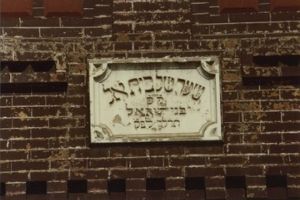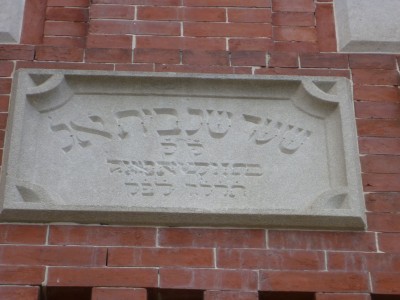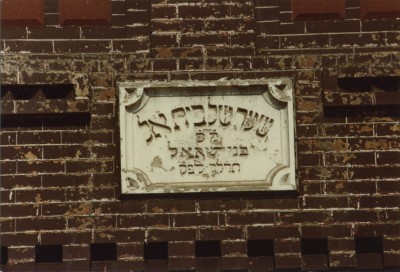A Mystery in Signage

 Hi everyone! My name is Ariella Esterson and I am one of the new Education interns here at the Jewish Museum of Maryland. I am currently finishing my undergraduate degree in History and Secondary Education at Queens College in New York. Since starting my internship a few weeks ago, I have been lucky enough to shadow some tours and help rewrite the docent tour script. While reading through the script and participating in a tour, I have recently noticed the Hebrew inscription that is located on the outside of B’nai Israel.
Hi everyone! My name is Ariella Esterson and I am one of the new Education interns here at the Jewish Museum of Maryland. I am currently finishing my undergraduate degree in History and Secondary Education at Queens College in New York. Since starting my internship a few weeks ago, I have been lucky enough to shadow some tours and help rewrite the docent tour script. While reading through the script and participating in a tour, I have recently noticed the Hebrew inscription that is located on the outside of B’nai Israel.
Looking at this plaque, I was left with many questions. When was it put up and more importantly what did it say? Being able to read and understand Hebrew, I was able to figure out that the first line read “Sh’ar Shel Beit El” with means in English “Gate of the House of God.” This is written to symbolize that this building is a synagogue or Jewish house of worship. After consulting with a book on Hebrew acronyms, I can safely assume that the second line, the “Kuf Kuf” stands for “Kehilla Kedosha” or “Holy Congregation.” The third line was when I started having some issues translating. It seemed to be like a bunch of gibberish, with letters strewn all over the place. It was hard to determine what each letter was, and I realized I needed to do some research. The fourth line I assumed was a date, but until I solved the mystery of the third line, I assumed the fourth line would make no sense.
While scanning the Past Perfect database, I finally stumbled on a picture of this plaque that was accessioned to the museum in 1987 (1987.173.071)
As one can clearly see from this picture, besides for the peeling paint and old feeling to the plaque, the third line is clearly visible. The letters spell out the name of the synagogue “B’nai Israel.” Now that I knew what line 2 said, I played detective and matched up those letters to the plaque that is up now. Taking a pen and outlining the letters that made the words “B’nai Israel,” I found that the leftover letters spelled “Chizuk Amuno,” the old synagogue that used to reside there! What a find!
Although I was able to decipher what the third line said, I was still left with a burning question. Which synagogue name was listed on the plaque first? I hoped that the fourth line would help shed some light on this question. I hoped that this would result in a date of when the plaque went up, which would reveal which synagogue was listed first. Using Gematria, which is assigning a numerical value to Hebrew letters, I was able to see that “Taf” equals 400, “Reish” equals 200, “Lamed” equals 30, and “Vav” equals 6, to make a grand total of 636. To my disappointment, this was not a year that I could use. My eyes then saw the last three letters on the plaque which are “Lamed” “Pey” and “Kuf.” Consulting once again my acronym dictionary, I got the words, “L’Prat Katan,” which in English means “Small details.” What this means is that back in the day when years were written they would leave out a letter (Hey, which in this case would be 5,000) from the beginning of the year, but they would put this acronym at the end to remind the reader to add the original 5,000. When that is added, there is now a grand total of 5,636. When this year is converted to the English year, you are left with 1876, the year Chizuk Amuno was established!
Based on this information, one can safely assume that “Chizuk Amuno” was etched in first on the plaque. When the building was bought by “B’nai Israel,” they covered up the original letters and re-etched the name of their synagogue. During the restoration period in the 1980’s, workers uncovered both synagogue names and decided to keep them both there for all visitors to see the transformation. I can now say mystery solved!



1 reply on “A Mystery in Signage”
wow! This post was so interesting. I have always wondered what the plaque above the door of B’nai Israel means. Thank you for doing all this investigative work!